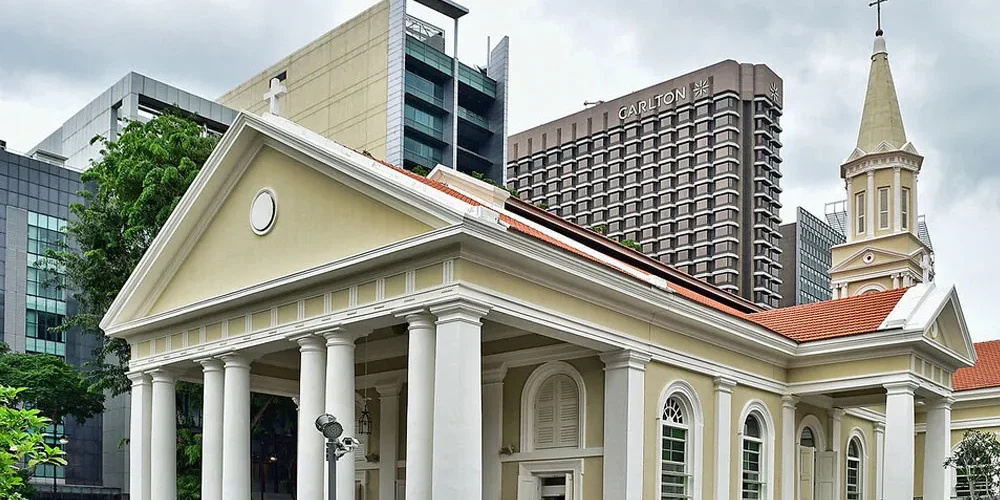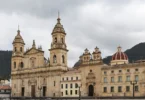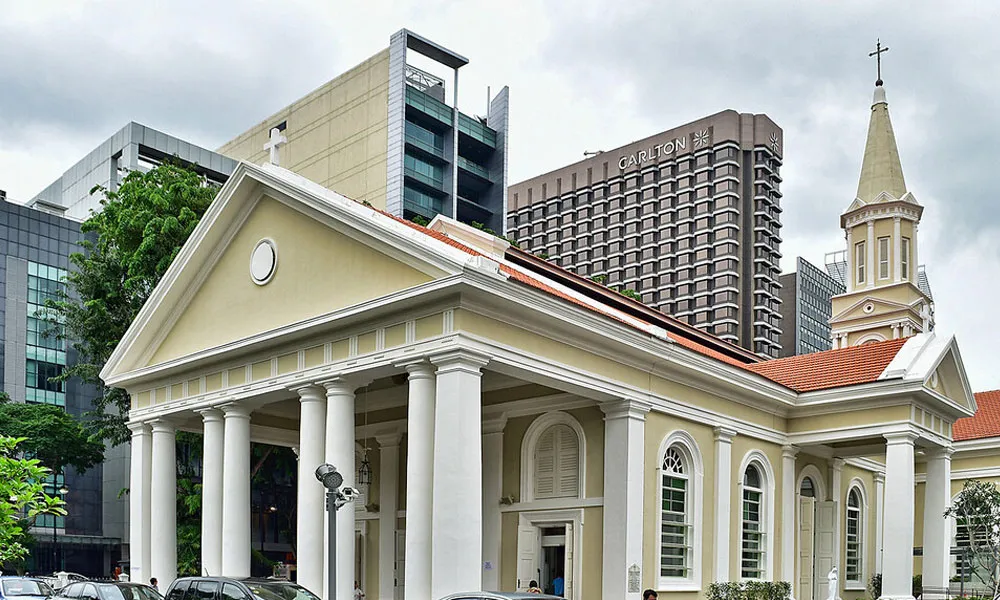
Introduction
The Cathedral of the Good Shepherd is the oldest Catholic church in Singapore, built in 1847. It is located in the Museum Planning Area within the Civic District. Bounded by the parallel Queen and Victoria Streets, and Bras Basah Road, the cathedral sits within shaded grounds. Much of its architecture is reminiscent of two famous London churches namely St Paul’s, Covent Garden and St Martin-in-the-Fields. The Cathedral of the Good Shepherd is the cathedral church of the Archdiocese of Singapore and the seat of its archbishop. It is the final resting place of Bishop Edouard Gasnier, the first bishop of the revived Diocese of Malacca and aptly houses the relics of Saint Laurent-Marie-Joseph Imbert, to whom the owes its name.
Bounded by the parallel Queen and Victoria Streets, and Bras Basah Road, the cathedral sits within shaded grounds. Much of its architecture is reminiscent of two famous London churches namely St Paul’s, Covent Garden and St Martin-in-the-Fields. The Cathedral of the Good Shepherd is the cathedral church of the Archdiocese of Singapore and the seat of its archbishop. It is the final resting place of Bishop Edouard Gasnier, the first bishop of the revived Diocese of Malacca and aptly houses the relics of Saint Laurent-Marie-Joseph Imbert, to whom the owes its name.
History Cathedral of the Good Shepherd
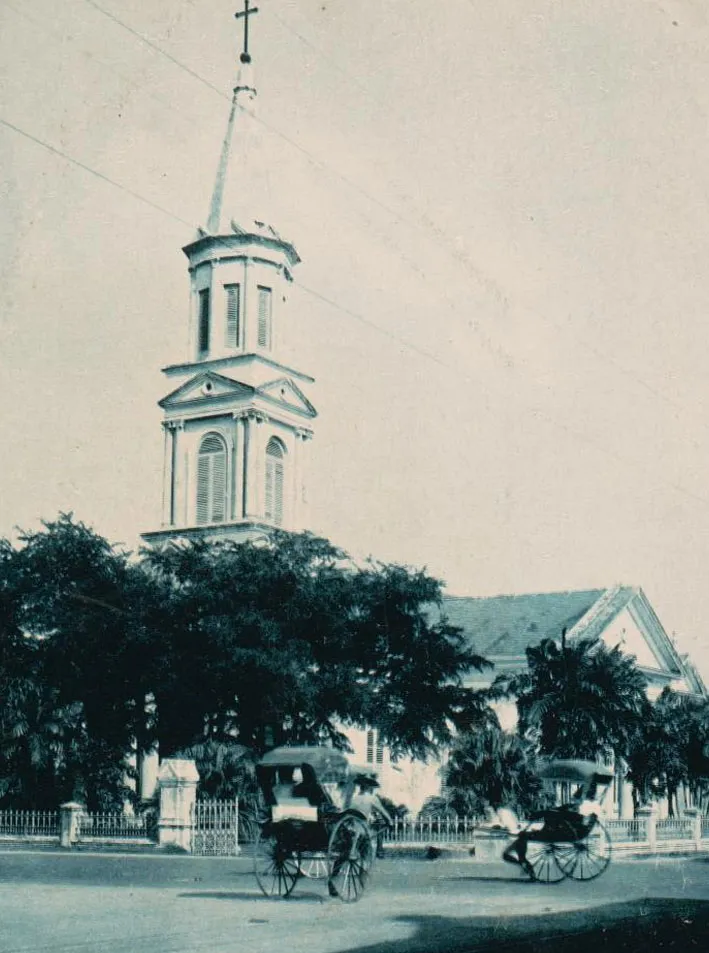
The history of the Catholic Church in Singapore began soon after Singapore was established as a British trading port in 1819, when European Catholics arrived on the island. These early Catholic pioneers worshipped in private homes until a small chapel made of wood and attap was erected on the site of the Former Saint Joseph’s Institution. The chapel soon proved to be too small for the rapidly expanding Catholic congregation. Reverend Father Jean-Marie Beurel, a priest from the Society of Foreign Missions of Paris (MEP), successfully obtained a plot of land from the government to build a brick-and-mortar church. In the beginning, the Catholic community in Singapore attended Mass at the house of Denis Lesley McSwiney.
In 1832, construction began on the first permanent Catholic house of worship in Singapore. Financed through public subscriptions, the chapel, completed by 1833, was a small wood and attap structure measuring 60 feet long by 30 feet wide that had cost about 700 Spanish dollars to build. The chapel, with neither tower nor spire, was on the site of the former Saint Joseph’s Institution buildings, now occupied by the Singapore Art Museum, and allotted by the Resident Councillor, George Bonham to Father Jean-Baptiste Boucho, a French missionary who had come from Penang. It was located in European Town, an area marked out in Sir Stamford Raffles’ 1822 town plan as a residential area for Europeans, Eurasians and wealthy Asians.
In 1888, the church was elevated to the status of cathedral when the Diocese of Malacca was revived. Bishop Edouard Gasnier, the first bishop of the revived Diocese of Malacca died in 1896 and is interred in the cathedral. His successor, Bishop René-Michel-Marie Fée, was the first bishop consecrated in the cathedral in 1896. Although the church was elevated to the status of cathedral in 1888, the consecration ceremony was performed only on 14 February 1897 when the cathedral had finally repaid its debts incurred from the extension of the nave in 1888. Improvements were gradually made to the cathedral. The dwarf wall, gate pillars, and ornamental cast iron gates and railings around the grounds were completed in 1908. The Gallery Organ was in place by 1912, while electric lighting came in 1913 and electric fans in 1914.
During the invasion of Singapore during World War II, the cathedral was used as an emergency hospital. The Cathedral of the Good Shepherd was gazetted a national monument on 28 June 1973. The cathedral went for a major structural restoration from 2013 to 2016 to address structural defects that resulted from new developments nearby. A new annexe building and basement to support the various functions of the cathedral were built. The restoration cost amounted to $42 million Singapore dollars. Saint Laurent-Marie-Joseph Imbert, who died a martyr in Korea, was probably the first priest to visit Singapore.
The dedication of the church to the Good Shepherd stems from the note written by Saint Laurent-Marie-Joseph Imbert to his fellow missionaries, Saints Pierre-Philibert Maubant and Jacques-Honoré Chastan, asking them to surrender to the Korean authorities to save their flocks from extermination during a period of Christian persecution in Korea. He had written, In desperate circumstances, the good shepherd lays down his life for his sheep. They did and the three of them were beheaded on 21 September 1839. News of this and their martyrdom reached Singapore at the time when an appropriate name was being considered for the church. The choice was made at the suggestion of Bishop Jean-Baptiste Boucho.
Architecture of Cathedral of the Good Shepherd
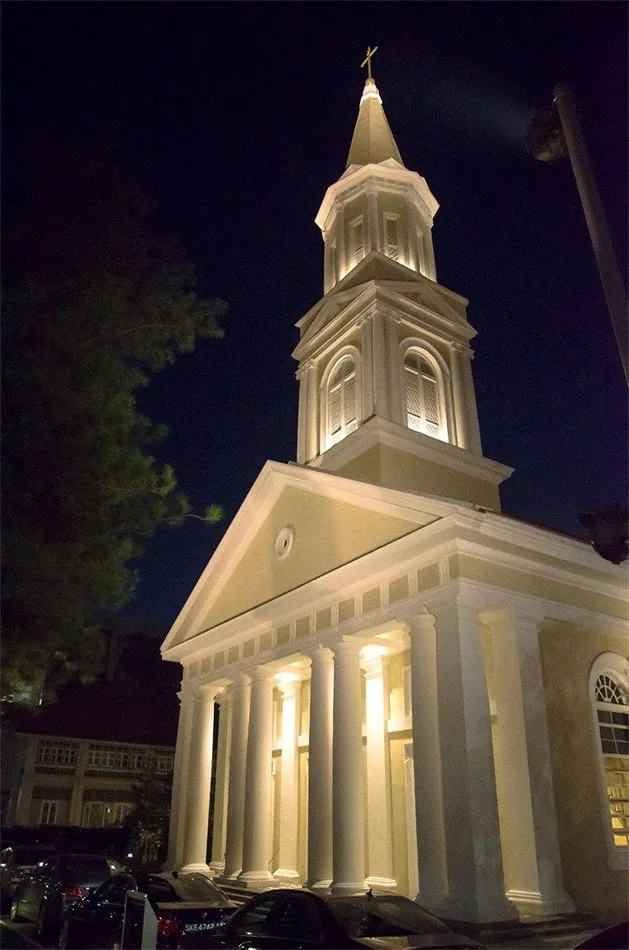
In 1840, a subscription drive was started whereby Queen Marie-Amélie Thérèse of France and the Archbishop of Manila contributed 4,000 francs and about 3,000 Spanish dollars respectively. The Government Surveyor, John Turnbull Thomson, had prepared the first design for the church, but it was considered too expensive to build and difficult to maintain. The design that was accepted was that by Denis Lesley McSwiney, a design that was said to owe much to George Drumgoole Coleman’s original Saint Andrew’s Church. On 18 June 1843, the cornerstone for the church was blessed by Bishop Jean-Paul-Hilaire-Michel Courvezy, Vicar Apostolic of Malacca-Singapore, and was laid by John Connolly, a merchant. In 1847, a steeple was added. It was designed by Charles Andrew Dyce who modelled it on John Turnbull Thomson’s design for the steeple added to the Saint Andrew’s Church. On 6 June 1847, the completed church was blessed and opened by Father Jean-Marie Beurel. The total payments amounted to 18,355.22 Spanish dollars. The Cathedral of the Good Shepherd is built in a restrained Renaissance style. Its porticos are in the Palladian manner, which was established here by George Drumgoole Coleman. Its plan is in the form of a Latin cross and like all traditional churches, it is orientated east.
On the wall of the sanctuary is a crucifix, It is framed by a pediment and four pilasters – two pilasters on a pedestal on either side of it. This reredos is not original, and was installed sometime in the 1960s, and is typical of the period, using standard glass mosaic tiles to create a ‘starburst’ background to the crucifix, as a replacement for the original high altar arrangement that was removed following the Second Vatican Council. At one point, the cathedra was moved to this spot where the high altar once stood, with the altar being moved forward as a free-standing ‘communion table’ style altar to allow versus populum celebration of the Mass. Following the most recent restoration, the traditional placement of the cathedra, to one side of the altar, has been reinstated. However, the decision was made to retain the 1960s reredos instead of reinstating the original high altar. However, the tabernacle was returned to its rightful place at the centre of the church, and a new retable was built for it. On either side of the main altar are doors that lead to the sacristy. A new altar table was also installed, of white marble and a more sympathetic design than the previous one, with a roundel containing a depiction of the Agnus Dei at its centre.
There were once niches over the doors (which were also round-headed to match the windows) on either side and in the centre that held statues, but they were filled in and plastered over at the time the reredos was replaced. Today the doors are of a more conventional rectangular shape, and where the niches once were is now blank wall that serves as projector screen. The four crosses engraved on marble slabs in the sanctuary together with the other eight in the nave make up the twelve consecration crosses put in place on the interior walls around the cathedral for its consecration in 1897. They may never be removed and are proof, in the absence of documents, that a church has been consecrated. Outside on the grounds of the cathedral near the main entrance was a bronze life-size statue of Pope John Paul II, the Glorious Cross of 7.38 meters and a statue of the Virgin Mary. A statue of the Good Shepherd stands opposite the entrance at the south transept.
After the 2016 restoration, the statue of the Virgin Mary and John Paul II statues were reinstalled in their original place. A new, contemporary crucifix is installed at the north transept entrance. A statue of the Homeless Jesus by Timothy Schmaltz is installed at the west end of the compound. The Good Shepherd statue has been moved to the crypt at the new basement.
Nave of Cathedral of the Good Shepherd
The nave is a simple hall without aisles. There are two transepts, also without aisles, and these are screened off by two doric columns on each side. Upon entering the cathedral through the centre door at the narthex, one will see the statues of Saint Anthony of Padua and Saint Francis Xavier, the four cast iron Composite columns supporting the gallery, and the two cast iron spiral staircases leading to the gallery. To the left sits a statue of the Pietà and a statue of Saint Joseph stands at the other end.
The eight large windows at the nave together with the other six at the transept and two at the sacristy are arched. There were originally eight large windows at the transept until the walling up of the two fronting Victoria Street. The original timber louvred casements of the windows were replaced by glass shutters with green glass in 1937. The stained glass windows in the lunettes of the nave and transept windows were presented to the cathedral by Bishop Charles Arsène Bourdon.
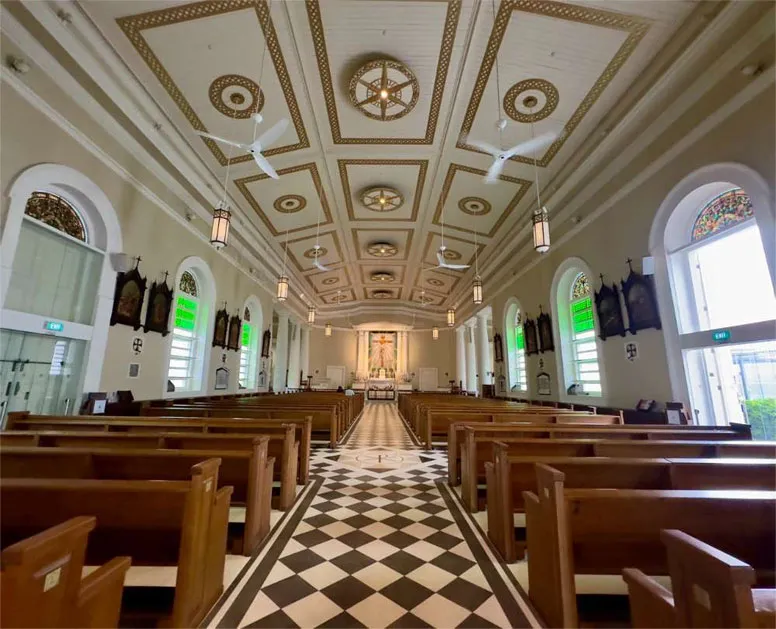
Feast Day
Feast Day: fourth Sunday of June
The Cathedral of the Good Shepherd celebrates its feast day on the fourth Sunday of June each year
Mass Timing
Weekdays:
Monday – Friday: 1:15 PM, 6:30 PM
Weekend:
Saturday: 6:00 PM
Sunday: 8:30 AM, 10:30 AM, 1:00 PM 5:30 PM
Contact Info
A Queen St,
Singapore 188533
Phone No.
Tel :+65 6337 2036
Accommodations
Connectivities
Airway
Changi Airport MRT Station to Cathedral of the Good Shepherd by subway
Distance: 19 km Duration: 38 min
Railway
Cathedral of the Good Shepherd, Singapore to Bras Basah, Bencoolen Distance: 470 m
Duration: 3 min

